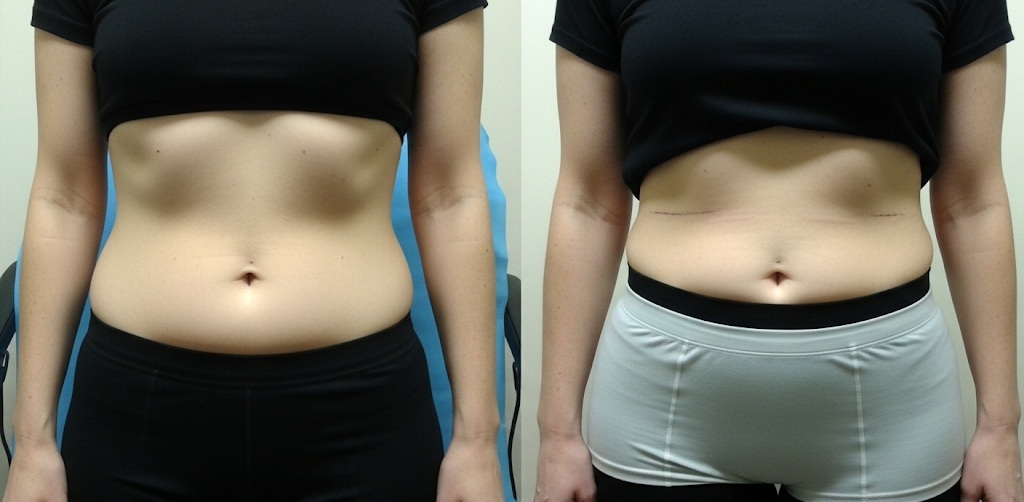There’s a lot of buzz about this online. But the truth is, the best answer will always come from an in-person consultation: is a tummy tuck the right choice for you, or would abdominal liposuction make more sense?
Belly fat and sagging skin are common concerns, especially after significant weight loss or pregnancy. You might feel healthier than ever, but still not love what you see in the mirror.
I get it. Most people like to do their homework before booking a consultation. You want to know exactly what these procedures involve, the difference between liposuction and tummy tuck, how long recovery really takes, and what kind of results you can expect.
A tummy tuck is very different from abdominal liposuction, but they have one thing in common: neither is a weight loss procedure. So what exactly are they? And which is better for you? That’s what we will help you answer here.
What is Abdominal Liposuction?
First, let’s break down the term. Literally, liposuction refers to “fat suction”; lipo means fat, and suction is exactly that: removing it.
So, abdominal liposuction is a cosmetic procedure used to remove stubborn fat from the belly. One of the key differences with a tummy tuck is that stomach liposuction only requires a few tiny 2 mm incisions. Through those, we insert a thin tube called a cannula to gently remove the fat.
During liposuction, the area is numbed, but you stay awake. That’s why we often refer to it as awake lipo.
When we talk about abdominal liposuction or stomach liposuction, we mean targeting the upper and lower belly to remove those stubborn fat deposits. This can also include the flanks and abs, and in body sculpting. Also, it’s often paired with lower back lipo, especially in 360° liposuction procedures.
One of its big advantages is its short recovery. After liposuction, patients get to go home the same day wearing their recovery garment. Most of them are back to their usual social activities within about five days. Full recovery takes around two to three months, to give you an idea of the time frame.
Who is stomach liposuction for? Generally, people who want to remove excess belly fat and have a BMI under 30. Depending on each case, this can be a good alternative procedure to reduce fat on the belly after weight loss or pregnancy.
Of course, stomach liposuction has its limitations. Depending on your health, skin elasticity, and body goals, it may or may not be enough on its own to sculpt your midsection.
Sometimes, though, fat isn’t the only concern. After pregnancy or major weight loss, you might also have separated abdominal muscles, small hernias, or significant loose skin. And that’s when the next procedure we are explaining here comes into play.
What is a Tummy Tuck?
The precise term for a tummy tuck in cosmetic surgery is abdominoplasty. It comes from abdomen (belly) and the Greek word plastos, meaning “molded.”
So, abdominoplasty literally means molding or reshaping your abdominal area.
That’s exactly what a tummy tuck is: a surgery that removes excess skin and fat from the abdomen, while also tightening abdominal muscles that may have separated (a condition known as diastasis recti). In some cases, it can also address small hernias, improving both firmness and contour.
The result? A flatter, firmer stomach.
A tummy tuck works deeper than liposuction, repairing muscle as well as removing skin. That’s why it’s a more invasive body contouring surgery, and also means recovery is longer and a bit more involved. Tummy tuck surgery typically leaves a scar about seven inches wide, placed low on the abdomen so it’s hidden under most underwear or swimwear.
For new moms, the recovery discomfort is often compared to a C-section: Tightness, soreness, and difficulty standing fully upright at first. Surgeons usually prescribe pain medication for the first days or weeks.
A tummy tuck is often the choice for people who have lost significant weight and are left with loose, sagging skin. Also, for women post-pregnancy whose abdominal muscles have stretched or separated.
Still, this is all to really address during consultations.
Also, it’s important not to confuse a tummy tuck with a “mommy makeover.” This is a combination of different procedures, often involving the abdomen, breasts, buttocks, and sometimes arms. But here, we’ll stick to explaining the tummy tuck.
As for recovery, expect at least two to three weeks of limited movement, about six months for full external healing, and up to a year (or even two) for complete internal recovery.
Too much info? I get it—that’s why I’ve put together a short comparison table below on tummy tuck vs abdominal liposuction.
Key Differences at a Glance
Before we compare each side by side, here’s a little insight: both stomach liposuction and tummy tucks have their place in cosmetic surgery. In fact, according to the American Society of Plastic Surgeons’ 2024 report, liposuction is the number one cosmetic surgery in the US, and tummy tucks come in at number three.
Both target the same body area—the belly—but they do it in very different ways. One is minimally invasive and focused on removing fat; the other is surgery to remove skin and repair muscle.
Recovery, scarring, and the overall process are also very different.
So, let’s break down liposuction vs tummy tuck for belly fat—what they’re for, how they work, and how long recovery takes.
Stomach liposuction vs tummy tuck Comparison table
| Stomach Liposuction | Tummy Tuck | |
| What it Targets | Specific fat deposits | Excess skin and tightened muscle |
| Best For | People with stubborn fat, people who lost weight | People who lost significant weight |
| How it Works | Uses a cannula to remove fat | Surgically removes skin and tightens muscle |
| Invasiveness | Minimally invasive, minimal bruising | More invasive surgery |
| Scarring | 2 mm incisions, easy to hide | 7-inch scar under the belly (may require scar management) |
| Anesthesia | Local anesthesia, patients are awake during the procedure | General anesthesia, patients are asleep |
| Hospital Stay | Outpatient—you go home the same day | At least one night in the clinic for monitoring |
| Initial Recovery | Return to activities in ~5 days | 2–3 weeks, with movement restrictions |
| Full Recovery | 2–3 months | ~6 months externally; up to 2 years internally |
Which One is Right for You?

With over 20 years of experience in cosmetic surgery and anesthesiology, I’ve seen it all—tummy tucks, mini tummy tucks, abdominal liposuction. And not one of those cases was exactly the same.
So, which is better for you: liposuction or a tummy tuck? The truth is, you won’t find the definitive answer by scrolling through the internet. The only way to know for sure is through a consultation with a board-certified cosmetic surgeon who is really experienced.
Here’s why: just because you have some sagging skin doesn’t automatically mean a tummy tuck is your only option. Even after pregnancy, many patients can benefit from less invasive alternatives, depending on their case.
You know what really makes the difference? Managing expectations and making informed decisions—understanding what results are realistic and achievable for your body.
One thing many surgeons don’t mention: a tummy tuck flattens the abdomen, but it doesn’t reshape your waistline or address surrounding areas like the love handles, lower belly fat, or lower back. That’s why we often see patients come to True Contour after surgeries done in other clinics—they’re looking to address those overlooked areas.
At True Contour, transparency is everything. You’ll always get a clear understanding of your options and the results you can expect. So, want to know if there’s another way to get rid of belly fat for good?
Is Liposuction + Skin Tightening An Alternative to a Tummy Tuck?
For patients with mild to moderate skin laxity and localized fat deposits, abdominal liposuction paired with Renuvion can deliver excellent results—without the long recovery of a tummy tuck.
Here’s how it works:
We start with PAL (Power-Assisted Liposuction) to precisely target and remove stubborn pockets of fat in the stomach and midsection. Incisions are tiny and strategically placed so they’re easy to hide.
Once the fat is removed, we use Renuvion for skin tightening, gently heating and contracting collagen-rich tissue to create a smoother, firmer contour.
From there, we close the incisions, you wear your recovery garment, and you rest for about 4–5 days. Most patients are well on their way to full recovery within three months.
Lipo or Tummy Tuck: What to Expect Post-Op
Before you decide whether or not you want a consultation, let’s go over one of the biggest concerns for these procedures: recovery. For both stomach liposuction or a tummy tuck, there are some common aftercare steps.
First, the garments: these are medical-grade compression garments, what we sometimes call “surgical foam.” One of the main differences here will be with pain management. With a tummy tuck, you’ll have more movement restrictions and will need to wear them for a longer period.
Surgeons always prescribe pain medications after a tummy tuck. In most cases, you won’t need any of these after liposuction.
Second, lymphatic massages: for both procedures, these help prevent fibrosis (scar tissue) and reduce swelling. At True Contour, we recommend them as part of a smooth, effective recovery plan.
Now, let’s look at two real cases so you can see how different situations can call for different approaches.
Case 1 – A Patient Considering a Tummy Tuck
I recently had a female patient who came in convinced she needed a tummy tuck. Her main concern was sagging belly skin—what we sometimes call “hangover skin.” Did she get that procedure?
No. After an in-depth consultation, we determined she didn’t actually need such an invasive procedure. Instead, we performed Lipo 360, targeting the abdomen and surrounding areas for a balanced, sculpted look. She got amazing results, and the best part, without going through the longer, tougher recovery of a tummy tuck.
Case 2 – Male Patient, 37 Years Old
We had a 37-year-old male patient looking to refine his midsection. We performed liposuction on the upper and lower abdomen plus the anterior flanks to sculpt and define his belly.
His recovery was smooth, and he was back to feeling confident in no time. Again, here there was no need for a tummy tuck, even though he first thought about it.
Confidence is the Real Goal
At the end of the day, it’s not just about the procedure; it’s about how you feel and how you want to look.
If your goal is to sculpt and contour your body, stomach liposuction is the more precise procedure. It targets stubborn fat, refines your shape, and does it with minimal downtime. A tummy tuck, on the other hand, is designed for flattening the abdomen and removing significant loose skin, especially after major weight loss or pregnancy.
Both procedures have their place in cosmetic surgery. Whether one or the other is better for you is something to decide after speaking with a professional. So instead of guessing, book a consultation at True Contour. Together, we’ll figure out whether a tummy tuck, liposuction—or even a combination—will give you the best results. That’s how you get clear answers, realistic expectations, and a plan tailored to your goals. So go ahead—the door is open!
